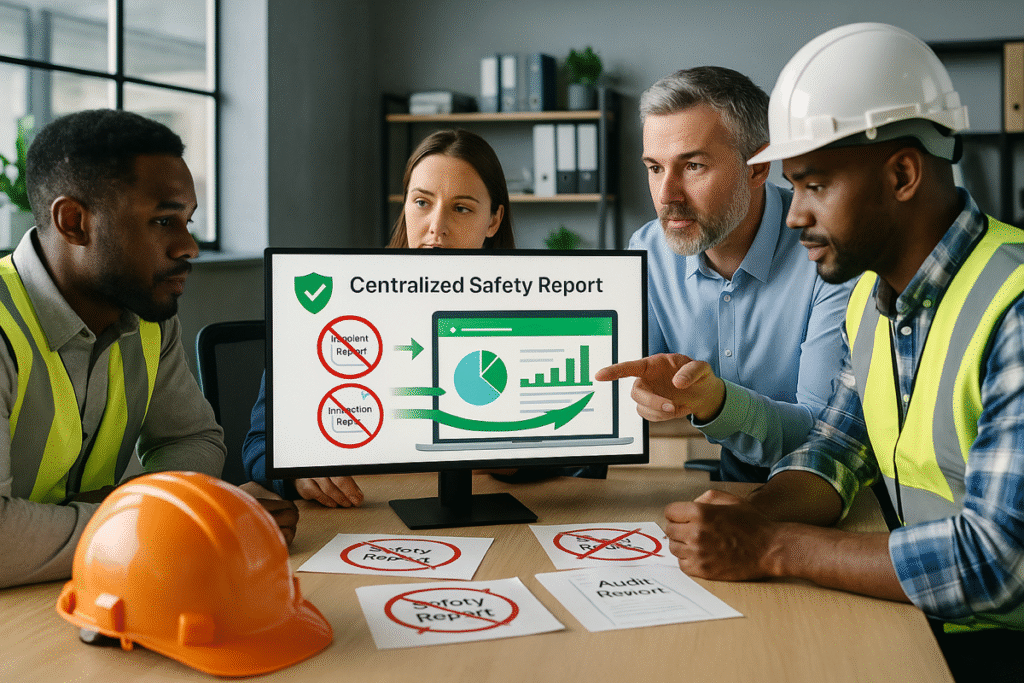
Eliminating Duplicate Reporting Systems: A Strategic Guide for EHS Leaders

Across many organizations, duplicate reporting systems are quietly undermining efficiency, accuracy, and compliance. Departments often operate with their own tools and data silos, resulting in fragmented insights and conflicting information. This inefficiency doesn’t just waste time it compromises the safety and reliability of operations in construction, transportation, general industry, and environmental management.
The consequences of duplicate reporting stretch across multiple layers. When administrative staff must enter the same incident, training, or maintenance data into multiple platforms, the likelihood of human error increases while valuable time is lost. Safety managers find themselves cross-checking reports instead of analyzing risks, and executives struggle with inconsistent metrics that mask critical trends. These challenges are not hypothetical. In healthcare, for instance, over 90% of duplicate records stem from registration errors, a pattern seen in other regulated sectors as well (McClellan, 2009).
In regulated industries, the need for unified reporting is paramount. Agencies such as the Occupational Safety and Health Administration (OSHA) (OSHA Injury and Illness Recordkeeping and Reporting Requirements, n.d.) and Environmental Protection Agency (EPA) (Compliance, n.d.) require traceable, verifiable data. Inconsistent reports can result in audit findings, compliance violations, and missed opportunities for hazard prevention. In the transportation sector, fragmented systems delay detection of fleet issues, while in construction, conflicting data from different field apps can stall investigations and inflate operational risks.
The solution lies in embracing a unified data management approach. Safety and health training must emphasize a centralized platform for reporting to ensure consistency across all departments. A single data source enables teams to respond faster to hazards, track patterns accurately, and implement control measures proactively. Advanced reporting tools, especially those integrated with AI and machine learning, unlock predictive insights that can prevent incidents before they occur (Predictive analytics and machine learning: Priority technologies for workplace safety, 2021).
To drive change, organizations must begin with a thorough audit to identify system overlap and high-duplication zones. From there, establishing clear governance standards and integrating tools such as middleware or application programming interfaces (APIs) allows for seamless communication across platforms. Real-time deduplication technology further enhances data quality by identifying and merging redundant entries as they occur (How Data Deduplication Streamlines Investigations and Reduces Risk, 2024).
Key Safety LLC supports this transformation by helping organizations build integrated reporting systems from the ground up. Our document development service ensures new projects launch with streamlined, compliant data frameworks. We also provide on-demand services to audit existing systems, deliver customized training, and implement modern data solutions. Through ongoing consultation, we help our clients maintain high-performing, efficient, and fully compliant EHS systems.
Unified reporting isn’t just a tech upgrade it’s a culture shift. Subscribe to our newsletter today and explore how Key Safety can guide your organization toward seamless, safe, and smart reporting.
References
Data Ladder. (2024). How Data Deduplication Streamlines Investigations and Reduces Risk. https://dataladder.com/how-data-deduplication-improves-investigations
McClellan, M. A. (2009). Duplicate medical records: A survey of Twin Cities healthcare organizations. AMIA Annual Symposium Proceedings, 2009, 421–425. https://www.ncbi.nlm.nih.gov/pmc/articles/PMC2815491
National Safety Council. (2021). Predictive analytics and machine learning: Priority technologies for workplace safety. https://www.nsc.org/getmedia/0e837673-651b-4763-bc99-b3991d32001a/predictive-analytics-machine-learning-priority-tech-wp.pdf
Occupational Safety and Health Administration. (n.d.). OSHA Injury and Illness Recordkeeping and Reporting Requirements. https://www.osha.gov/recordkeeping
U.S. Environmental Protection Agency. (n.d.). Compliance. https://www.epa.gov/compliance
Comments:

